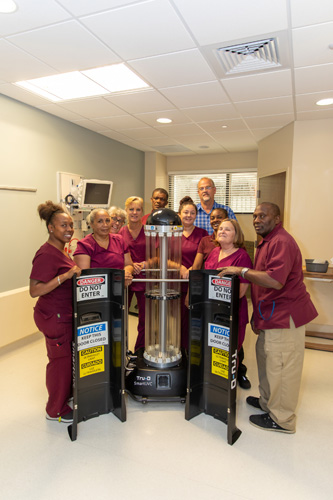
Can any hospital in Florida offer patients a room that’s 100 percent guaranteed COVID-19 virus-free?
Maybe. But it would be a tricky thing to accomplish.
Roughly six months ago Sebastian River Medical Center unveiled a Tru-D Ultra-Violet-C robot. It’s a device that uses low-pressure mercury gas bulbs to emit a strong, narrow band of the UV-C light spectrum in locked and empty patient rooms that kills bacteria, spores and viruses like COVID-19 by disrupting their DNA and preventing them from reproducing.
But there is a hitch in that performance promise – it’s the phrase, “like COVID-19.”
The robot’s UV light has not been tested specifically on the COVID-19 virus which, current research shows, can survive on hard surfaces such as patient tables, trays and bed frames for up to 72 hours.
The light is known to kill similar viruses, so it seems likely it kills COVID-19 but there has not been a study to prove that.
Still, the BBC reports that Dr. Hans Jørn Kolmos, a professor of clinical microbiology at the University of Southern Denmark, says this type of robot is up to the task.
“Coronavirus,” says Kolmos, “is very similar to other viruses like MERS and SARS. And we know that they are being killed by UV-C light.”
The Sebastian River Medical Center’s chief nursing and operating officer, Ralph Taylor, explains how the Tru-D robot is being used.
“Once [our] environmental services team cleans and disinfects a patient room or operating room with traditional stringent methods, the Tru-D is rolled in to complete the disinfection process,” Taylor says. “It is activated by a remote control outside the room and alerts the operator via audio and/or text message when the cycle is complete, and Tru-D can be moved to the next room.”
But that leads to another potential hiccup in providing a hospital full of totally COVID-19 virus-free patient rooms.
Time.
According to Taylor, “on average, a Tru-D cycle takes around 20 minutes to treat a patient room. Tru-D’s sensors are able to analyze a room for size, contents and shape and takes whatever time is necessary to fully disinfect a room.”
When used in operating rooms, Taylor adds, “a Tru-D cycle takes around 30 minutes. ORs are generally larger than patient rooms and have more equipment in the space, which requires a longer Tru-D cycle.”
With 60 minutes in an hour and 24 hours in a day, it would take this one Tru-D a full day to clean fewer than half the hospital’s patient rooms – and none of its operating rooms – and that estimate presumes the robot is run non-stop 24 hours a day and its operator never takes a coffee break.
The good news? Since the Sebastian hospital started using its Tru-D robot, according to Taylor, “hospital-acquired complications related to infection are down 21 percent and surgical-site infection rates were down an impressive 100 percent.”
The price for ultraviolet devices like the Tru-D robot range from about $70,000 to $125,000 and the World Health Organization warns these robots – or any high-powered ultraviolet devices – fall squarely into the “do not try this at home” category.
“UV lamps should not be used to sterilize hands or other areas of skin as UV radiation can cause serious harm to your skin,” says the WHO.
When asked if a second Tru-D or similar robotic device might be in the cards for SRMC anytime soon, so that more rooms could be treated, Taylor says “we are looking at adding an additional robot after the completion of our new wing.”
That’s probably great news, but it will likely be too late to help clean patient and operating rooms during the current COVID-19 pandemic.
Moreover, based on the information currently available, no matter how clean – or even COVID-19 virus-free – any room can be made, it would only take one person who has the virus to re-infect that space with a cough, a sneeze or a touch of their unwashed hands.



